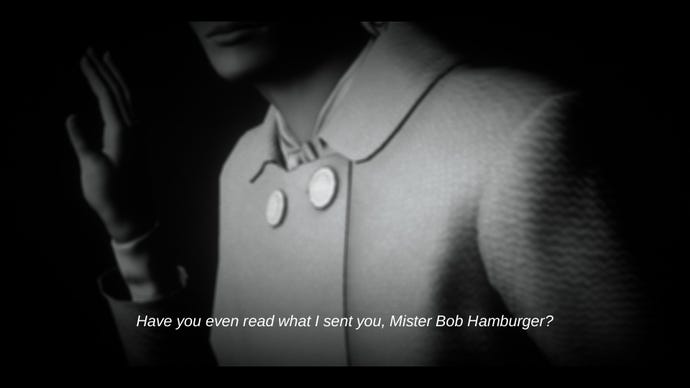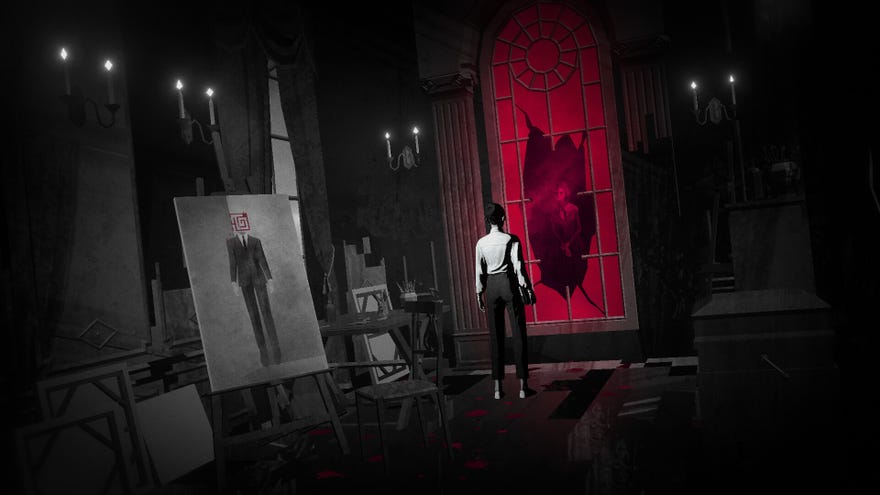Lorelei And The Laser Eyes doesn’t let its surreal creativity strip its puzzles of logic
Simogo on then
“In one of Nero’s many manifests,” reads a books in surreal puzzle-box Lorelei And The Laser Eyes, referring to its eccentric (read: tastefully deranged) antag-artist, “there is a satirical proposal claiming that only dictators should be allowed to direct films.” Developers Simogo - of well-deserved Sayonara Wild Hearts and Device 6 acclaim - seem to agree that’s a position worth satirising. Lorelei, despite its single-solution puzzles, is not dictatorial. It’s far too interested in collaborating with you for that. It wants you to observe, consider, and interpret its many mysteries. What’s really hooked me here is how those puzzles are kept coherent and logical, despite you getting delivered a letter by dog and occasionally visiting a floppy disk bizzaro world where you converse with a magician who manifests from his own discarded hat.
It’s 1963. Renzo Nero, the aforementioned artist and director, has called you to his Italian hotel to witness a transcendental cosmic event via his ‘magnum opus’. If you’ve ever gotten drunk with fine art students, you’ll know this usually just means ‘my latest ketamine doodle’, but there's an immediate splash of the otherworldly about the place. Sometimes that splash is a literal spray of magenta breaking up an otherwise monochrome palette, but it’s also in the stilted surreality of the few conversations you have with the hotel’s inhabitants. Initially, it’s most keenly felt in a place you’d expect to be straightforward: an instruction manual, found in a glovebox.
Here’s a short list of tiny details in the first hour or so of Lorelei that made me think “Ah, I see what you’re doing here…actually, no I don’t, but I like it!”: Your character can only sprint if they first drink coffee. The instruction manual warns you about how important it is to pay attention to characters in owl masks, and also to take guns pointed at your face seriously. You can choose whether or not to wash your hands after using the loo. The fixed-camera angle and winding mansion homage to Resident Evil is almost immediately sent-up by having the first dog you meet be a sweetheart. You will find american dollars hidden in the stangest places, and the only use for them I've currently found is to buy cute Gashapon from a machine in a dilapidated basement. Once you’ve finished rifling around in your car, you can ‘lock it’ or ‘leave it unlocked’. That, mates, is how you make me deeply paranoid in three words or less. A truly ominous use of a mundane selectable.
The instruction manual’s most useful advice, as Katharine observed in her preview, is that you’ll want to have a notebook handy. Here’s where that lovely separation comes in - that division between ‘things you can look up on Wikipedia’ and ‘things you’d expect to find scrawled on a note made out of skin submerged in an absinthe bottle’. The puzzles are all logic: cross-referencing previously found clues - like the release dates of films written on a pile of old videotapes with padlock codes - or using real-world knowledge of things like Roman numerals. Some of the puzzles are literally just maths, for which you’re gifted a not-Gameboy with a built-in calculator. They’re by no means easy, but so far, I’ve appreciated how the game makes clear which tools you’ll need to solve something. It doesn’t walk you through the door, but it will point the way.

As I said though, despite that separation, the puzzles are still all grounded within this overarching mystery. What’s key here for me, as someone who loves a clever puzzle in a survival horror game but isn't fussed about them for their own sake, is that Lorelei’s rewards run deeper than just the satisfaction of overcoming a head-scratcher. This is a place I want to explore and a story I’m desperate to uncover. Encounters with Nero build mystique around a character that becomes more disturbing with each meeting, with each scrap of information I glean about his work making his empty ramblings seem more menacing. And, while Lorelei shares more DNA with mobile puzzler Device 6, Sayonara Wild Hearts’ passion for music eerily earworms its way through scattered phonographs.
I’ve mentioned survival horror a few times now, but please don’t be put off if that’s not your thing! There’s absolutely no combat or inventory management, for one. And, unless there’s a big tonal shift later, I can’t see you having to outrun any dogs, either. There are parallels, though. The fixed camera for one, but mostly the sense of creating a mental map of a sprawling single location. You can find maps, although even the process of accessing them is multi-tiered and thoughtful and a touch fiendish, if only because I was massively overthinking the solution. That’s another thing: there’s no moon logic here. Again, Lorelei saves the surreal for its setting, while its challenges are grounded, sensical, and give a lovely sense of having traced an A to a B once solved.
Wonderful, too, is the hotel’s openness. I do get the sense there’s probably a perfect order to these puzzles, but it doesn’t feel enforced. It leaves me to pick at surface parts that look manageable, like a bastard-hot lasagna, nibbling it down to what I’m sure will be a molten centre of an overarching puzzle I’ll have to sit, consider, and let cool. So far, though, the sense of progress is steady, the mystery tantalising, and the atmosphere unbroken by frequent nudges to leave the fiction and enter the real world to check which of my desktop pencils are sharpened. And if you can keep me immersed while I’m off sharpening pencils, you’re on to real winner. And if you can do it while keeping things this logical, you've got my trust as a player that the solution is never out of reach, no matter how strange things might eventually get.


